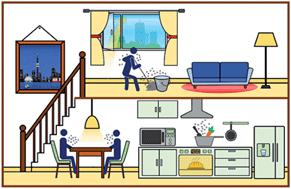当前位置:
X-MOL 学术
›
Environ. Sci.: Processes Impacts
›
论文详情
Our official English website, www.x-mol.net, welcomes your
feedback! (Note: you will need to create a separate account there.)
The atmospheric chemistry of indoor environments.
Environmental Science: Processes & Impacts ( IF 4.3 ) Pub Date : 2019-10-31 , DOI: 10.1039/c9em00386j Jonathan P D Abbatt 1 , Chen Wang 1
Environmental Science: Processes & Impacts ( IF 4.3 ) Pub Date : 2019-10-31 , DOI: 10.1039/c9em00386j Jonathan P D Abbatt 1 , Chen Wang 1
Affiliation

|
Through air inhalation, dust ingestion and dermal exposure, the indoor environment plays an important role in controlling human chemical exposure. Indoor emissions and chemistry can also have direct impacts on the quality of outdoor air. And so, it is important to have a strong fundamental knowledge of the chemical processes that occur in indoor environments. This review article summarizes our understanding of the indoor chemistry field. Using a molecular perspective, it addresses primarily the new advances that have occurred in the past decade or so and upon developments in our understanding of multiphase partitioning and reactions. A primary goal of the article is to contrast indoor chemistry to that which occurs outdoors, which we know to be a strongly gas-phase, oxidant-driven system in which substantial oxidative aging of gases and aerosol particles occurs. By contrast, indoor environments are dark, gas-phase oxidant concentrations are relatively low, and due to air exchange, only short times are available for reactive processing of gaseous and particle constituents. However, important gas–surface partitioning and reactive multiphase chemistry occur in the large surface reservoirs that prevail in all indoor environments. These interactions not only play a crucial role in controlling the composition of indoor surfaces but also the surrounding gases and aerosol particles, thus affecting human chemical exposure. There are rich research opportunities available if the advanced measurement and modeling tools of the outdoor atmospheric chemistry community continue to be brought indoors.
中文翻译:

室内环境的大气化学。
通过吸入空气,吸入粉尘和皮肤接触,室内环境在控制人体化学暴露方面起着重要作用。室内排放物和化学物质也会直接影响室外空气的质量。因此,重要的是要对室内环境中发生的化学过程有很强的基础知识。这篇综述文章总结了我们对室内化学领域的理解。从分子角度看,它主要解决了过去十年左右的新进展以及我们对多相分配和反应的理解的发展。本文的主要目的是将室内化学物质与室外化学物质进行对比,我们知道这是一种强气相,氧化剂驱动的系统,其中气体和气溶胶颗粒发生大量的氧化老化。相反,室内环境是黑暗的,气相氧化剂的浓度相对较低,并且由于空气交换,仅短时间可用于气态和颗粒成分的反应性处理。但是,重要的气体-表面分配和反应性多相化学反应会在所有室内环境中普遍存在的大型地表储层中发生。这些相互作用不仅在控制室内表面的组成方面起着至关重要的作用,而且在周围的气体和气溶胶颗粒方面也起着至关重要的作用,从而影响人体的化学暴露。如果继续将室外大气化学界的先进测量和建模工具带入室内,则将有丰富的研究机会。相反,室内环境是黑暗的,气相氧化剂的浓度相对较低,并且由于空气交换,仅短时间可用于气态和颗粒成分的反应性处理。但是,重要的气体-表面分配和反应性多相化学反应会在所有室内环境中普遍存在的大型地表储层中发生。这些相互作用不仅在控制室内表面的组成方面起着至关重要的作用,而且在周围的气体和气溶胶颗粒方面也起着至关重要的作用,从而影响人体的化学暴露。如果继续将室外大气化学界的先进测量和建模工具带入室内,则将有丰富的研究机会。相反,室内环境是黑暗的,气相氧化剂的浓度相对较低,并且由于空气交换,仅短时间可用于气态和颗粒成分的反应性处理。但是,重要的气体-表面分配和反应性多相化学反应会在所有室内环境中普遍存在的大型地表储层中发生。这些相互作用不仅在控制室内表面的组成方面起着至关重要的作用,而且在周围的气体和气溶胶颗粒方面也起着至关重要的作用,从而影响人体的化学暴露。如果继续将室外大气化学界的先进测量和建模工具带入室内,则将有丰富的研究机会。仅短时间可用于气态和颗粒成分的反应性处理。但是,重要的气体-表面分配和反应性多相化学反应会在所有室内环境中普遍存在的大型地表储层中发生。这些相互作用不仅在控制室内表面的组成方面起着至关重要的作用,而且在周围的气体和气溶胶颗粒方面也起着至关重要的作用,从而影响人体的化学暴露。如果继续将室外大气化学界的先进测量和建模工具带入室内,则将有丰富的研究机会。仅短时间可用于气态和颗粒成分的反应性处理。但是,重要的气体-表面分配和反应性多相化学反应会在所有室内环境中普遍存在的大型地表储层中发生。这些相互作用不仅在控制室内表面的组成方面起着至关重要的作用,而且在周围的气体和气溶胶颗粒方面也起着至关重要的作用,从而影响人体的化学暴露。如果继续将室外大气化学界的先进测量和建模工具带入室内,则将有丰富的研究机会。这些相互作用不仅在控制室内表面的组成方面起着至关重要的作用,而且在周围的气体和气溶胶颗粒方面也起着至关重要的作用,从而影响人体的化学暴露。如果继续将室外大气化学界的先进测量和建模工具带入室内,则将有丰富的研究机会。这些相互作用不仅在控制室内表面的组成方面起着至关重要的作用,而且在周围的气体和气溶胶颗粒方面也起着至关重要的作用,从而影响人体的化学暴露。如果继续将室外大气化学界的先进测量和建模工具带入室内,则将有丰富的研究机会。
更新日期:2019-10-31
中文翻译:

室内环境的大气化学。
通过吸入空气,吸入粉尘和皮肤接触,室内环境在控制人体化学暴露方面起着重要作用。室内排放物和化学物质也会直接影响室外空气的质量。因此,重要的是要对室内环境中发生的化学过程有很强的基础知识。这篇综述文章总结了我们对室内化学领域的理解。从分子角度看,它主要解决了过去十年左右的新进展以及我们对多相分配和反应的理解的发展。本文的主要目的是将室内化学物质与室外化学物质进行对比,我们知道这是一种强气相,氧化剂驱动的系统,其中气体和气溶胶颗粒发生大量的氧化老化。相反,室内环境是黑暗的,气相氧化剂的浓度相对较低,并且由于空气交换,仅短时间可用于气态和颗粒成分的反应性处理。但是,重要的气体-表面分配和反应性多相化学反应会在所有室内环境中普遍存在的大型地表储层中发生。这些相互作用不仅在控制室内表面的组成方面起着至关重要的作用,而且在周围的气体和气溶胶颗粒方面也起着至关重要的作用,从而影响人体的化学暴露。如果继续将室外大气化学界的先进测量和建模工具带入室内,则将有丰富的研究机会。相反,室内环境是黑暗的,气相氧化剂的浓度相对较低,并且由于空气交换,仅短时间可用于气态和颗粒成分的反应性处理。但是,重要的气体-表面分配和反应性多相化学反应会在所有室内环境中普遍存在的大型地表储层中发生。这些相互作用不仅在控制室内表面的组成方面起着至关重要的作用,而且在周围的气体和气溶胶颗粒方面也起着至关重要的作用,从而影响人体的化学暴露。如果继续将室外大气化学界的先进测量和建模工具带入室内,则将有丰富的研究机会。相反,室内环境是黑暗的,气相氧化剂的浓度相对较低,并且由于空气交换,仅短时间可用于气态和颗粒成分的反应性处理。但是,重要的气体-表面分配和反应性多相化学反应会在所有室内环境中普遍存在的大型地表储层中发生。这些相互作用不仅在控制室内表面的组成方面起着至关重要的作用,而且在周围的气体和气溶胶颗粒方面也起着至关重要的作用,从而影响人体的化学暴露。如果继续将室外大气化学界的先进测量和建模工具带入室内,则将有丰富的研究机会。仅短时间可用于气态和颗粒成分的反应性处理。但是,重要的气体-表面分配和反应性多相化学反应会在所有室内环境中普遍存在的大型地表储层中发生。这些相互作用不仅在控制室内表面的组成方面起着至关重要的作用,而且在周围的气体和气溶胶颗粒方面也起着至关重要的作用,从而影响人体的化学暴露。如果继续将室外大气化学界的先进测量和建模工具带入室内,则将有丰富的研究机会。仅短时间可用于气态和颗粒成分的反应性处理。但是,重要的气体-表面分配和反应性多相化学反应会在所有室内环境中普遍存在的大型地表储层中发生。这些相互作用不仅在控制室内表面的组成方面起着至关重要的作用,而且在周围的气体和气溶胶颗粒方面也起着至关重要的作用,从而影响人体的化学暴露。如果继续将室外大气化学界的先进测量和建模工具带入室内,则将有丰富的研究机会。这些相互作用不仅在控制室内表面的组成方面起着至关重要的作用,而且在周围的气体和气溶胶颗粒方面也起着至关重要的作用,从而影响人体的化学暴露。如果继续将室外大气化学界的先进测量和建模工具带入室内,则将有丰富的研究机会。这些相互作用不仅在控制室内表面的组成方面起着至关重要的作用,而且在周围的气体和气溶胶颗粒方面也起着至关重要的作用,从而影响人体的化学暴露。如果继续将室外大气化学界的先进测量和建模工具带入室内,则将有丰富的研究机会。











































 京公网安备 11010802027423号
京公网安备 11010802027423号